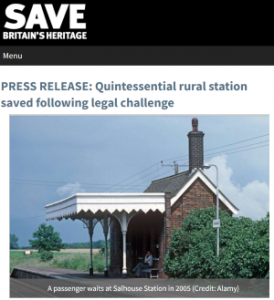 Legal action by SAVE Britain’s Heritage has helped secure a reprieve for one of the smallest and most delightful country stations on the railway network, Salhouse, north of Norwich, on the line up to the fashionable seaside resorts of Cromer and Sheringham.
Legal action by SAVE Britain’s Heritage has helped secure a reprieve for one of the smallest and most delightful country stations on the railway network, Salhouse, north of Norwich, on the line up to the fashionable seaside resorts of Cromer and Sheringham.
… we swiftly challenged the permission, and the decision has now been officially quashed…
SAVE Britain’s Heritage writes:
In October 2021, train operating company Abellio Greater Anglia had been given the go-ahead by Broadland Council to demolish the station under permitted development rights. Under Anglia’s plans, the waiting room and dogtooth canopy on the Norwich-bound platform were to have been replaced by a prefabricated glazed bus shelter, robbing the line of one its most picturesque stations.
However, working with Richard Harwood QC and Susan Ring of Harrison Grant Solicitors, we swiftly challenged the permission, and the decision has now been officially quashed.
Marcus Binney, executive president of SAVE Britain’s Heritage, says: “This is the second of several pre-emptive demolitions of country railway stations which SAVE is currently challenging in East Anglia. Brandon Station was previously saved by another SAVE court order and has now been listed. We are now working with Suffolk BPT on a scheme for its reuse.”
Henrietta Billings, director of SAVE Britain’s Heritage says: “This programme of bulldozing our rural Victorian railway heritage must stop. Replacing these historic buildings with bland bus shelter canopies is a loss for everyone. Visitors and passenger alike love these 19th century railway buildings which chart the travelling history of our railways and the people who built them. We call on Greater Anglia to celebrate these buildings and look after them as assets to treasure.”
Judith Harwood, Chair of the Norfolk Historic Buildings Trust, says: “The Trust wholeheartedly supports SAVE’s listing application. We strongly recommend that GA engages properly with local communities before considering any further plans to “modernise” its stations.”
Art historians are now keenly studying the station to decide whether it is the work of the much-admired Norwich architect Thomas Jeckyll, who was recently honoured by an exhibition in the Bard Institute in New York, curated by Susan Soros Weber.
In his later years Jeckyll excelled in the design of metalwork (strongly influenced by Japanese design) which was produced in impressive quantities by the firm of Barnard Bishop and Barnards.
Jekyll however died in 1881 several years before the station was built and it is considered more likely that the little station was designed by the leading railway engineer William Neville Ashbee, who designed the impressive terminus station in Norwich itself.
Ashbee was the chief architect of the Great Eastern Railway from 1883. He is known to have been responsible for the station building at Prittlewell in Essex (line opened 1889), where there is very similar ironwork to that at Salhouse. On the basis of this impressive architectural pedigree, SAVE has submitted an application for the urgent listing of Salhouse Station as a building of special architectural and historic interest.
Our listing application has drawn support for a number leading architectural historians and the Norfolk Historic Buildings Trust. Martin Levy, a leading expert on the period writes in his letter to Historic England, “The loss of Salhouse station would destroy a significant architectural gem. The distinctive iron supports, probably by Barnard, Bishop, and Barnards, reflect the ongoing influence of Thomas Jeckyll.”
SAVE is now working with the Norfolk Historic Buildings Trust on a proposal for the repair and reuse of the station building.

